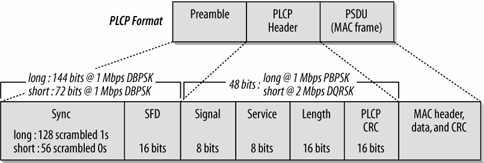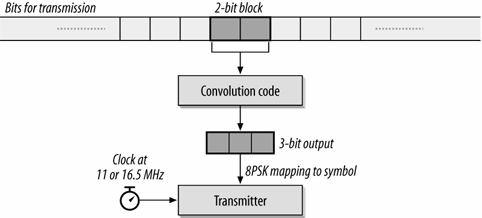ERP Physical Layer Convergence (PLCP)
The ERP PHY's convergence layer is quite complicated. Due to the plethora of operational modes, there are a number of different ways that frames will be bundled up for transmission by the radio interface. Each of the modes described at the start of the chapter has its own physical layer framing.
ERP-OFDM Framing
This mode is the meat of the specification. All stations are required to implement it, and it is what is colloquially meant by "802.11g support" because most stations default to using it. In practice, understanding ERP-OFDM physical framing will provide you with the understanding of most 802.11g transmissions in the air.
The format of the ERP-OFDM frame at the physical layer, shown in Figure 14-3, is nearly identical to 802.11a. ERP-OFDM uses an identical logical protocol data unit, shown as the top line of the figure. In fact, the only major difference from 802.11a is that the frame is followed by a six microsecond idle time called the signal extension, which is shown in the second line of the figure, where the logical construction is assembled for transmission. The reason for the extra 6 ms is to make timing calculations and frame rates identical to 802.11a. 802.11a uses a 16 ms SIFS time, which is used in part to finish decoding the previous frame. For backwards compatibility, 802.11g uses the 10 ms idle time used by 802.11b. To provide enough time for the decoding process to finish, 802.11g adds 6 ms idle time to the end of the frame, leaving a 16 ms gap for the hardware to run its decode process. Of course, the NAV is set so that the virtual carrier sense mechanism reports the medium idle after the signal extension period completes. In the lower line, the OFDM transmissions are shown. It is identical to 802.11a.
Single-Carrier Framing with 802.11g
Although the OFDM modulation discussed in the previous section is by far the most common, it is also possible to use 802.11b-compatible framing directly around the higher speed body. Traditional framing is used with both the packet binary convolution coding and the DSSS-OFDM layer. Because older 802.11b stations can read the frame header, they can avoid using the medium during transmission and do not require protection. Figure 14-4 shows the use of traditional single-carrier framing in 802.11g.
Preamble
The Preamble is identical to the 802.11b preamble discussed in Chapter 12, and consists of a synchronization field followed by a start of frame delimiter. It may be either the long preamble of 144 bits or the short preamble of 72 bits. In either case, the Preamble is transmitted at 1 Mbps using DBPSK modulation. Before modulation, the data is scrambled just as it is in 802.11b.
Figure 14-3. ERP-OFDM PLCP frame format

Figure 14-4. Long preamble ERP PLCP frame format

PLCP Header
The PLCP header is identical to the PLCP header discussed in Chapter 12. It consists of the Signal field, Service field, a Length field, and a PLCP-layer CRC check. The Length and CRC fields are identical to the 802.11b interpretation.
Signal field
This field is used to show the rate at which the PLCP payload (the MAC frame) is modulated. Initially, it was defined as the multiplier of 100 kbps that would result in the encoding rate. With the field defined as only eight bits, it would limit the encoding speed to 25.5 Mbps. To accommodate increased speeds, the Signal field consists of a label that describes the speed, as shown in Table 14-1. The signal field is not needed to tell the receiver what the encoding rate of a DSSS-OFDM frame is because there is a separate OFDM header to perform that task.
|
Speed |
Signal field value (hex/binary) |
Signal field value, decimal |
|---|---|---|
|
1 Mbps (ERP-DSSS) |
0x0A (0000 1010) |
10 |
|
2 Mbps (ERP-DSSS) |
0x14 (0001 0100) |
20 |
|
5.5 Mbps (ERP-CCK, ERP-PBCC) |
0x37 (0011 0111) |
55 |
|
11 Mbps (ERP-CCK, ERP-PBCC) |
0x6E (0110 1110) |
110 |
|
22 Mbps (ERP-PBCC) |
0xDC (1101 1100) |
220 |
|
33 Mbps (ERP-PBCC) |
0x21 (0010 0001) |
33 |
|
Any DSSS-OFDM speed |
0x1E (0001 1110) |
30 |
Service field
The service field, shown in Figure 14-5, contains control bits to help the receiver decode the frame. As discussed previously, bits 0, 1, and 4 are reserved and must be set to zero. In all 802.11g stations, the transmit and symbol clocks are locked, so bit 2 is always set to 1. Bit 3 is set when the frame body is modulated with PBCC, and set to zero for DSSS, CCK, and DSSS-OFDM modulations. The last three length extension bits are used to assist receivers in determining the frame length in bytes from the Length field, which is expressed in terms of the number of microseconds required for transmission. The standards have a complicated set of rules for when the bits must be set, but they are beyond the level of detail required for this book, especially since the single-carrier framing technique is uncommon.
Figure 14-5. 802.11g SERVICE field

Frame Body
The final component of the PLCP frame is its payload, which is the MAC frame, modulated either by PBCC or OFDM. Details of the frame body modulation will be discussed in subsequent sections.
PBCC coding
To transmit a frame using PBCC, the frame data is first run through a convolutional code. The frame is broken into 2-bit elements, and are used as input into a convolutional code that outputs three bits. Each 3-bit block is mapped on to a symbol using 8PSK. Receivers will reverse the process, translating a single phase shift into one of eight symbols. After translating the symbol to a three-bit sequence, the convolutional code is used to remove the redundant bit and recover the original data. See Figure 14-6.
Figure 14-6. PBCC processing

Achieving a 22 Mbps data rate with this physical encoding is straightforward. The symbol clock continues to run at 11 MHz, just as in 802.11b, but each symbol is now capable of transmitting two bits. To run at 33 Mbps, the symbol rate for the data portion of the frame must be increased to 16.5 MHz. At two bits per symbol, the overall data rate is 33 Mbps. Clock speed switching must occur between the PLCP preamble and its payload.
DSSS-OFDM framing
DSSS-OFDM is a hybrid framing technique. The higher-layer packet is encoded with OFDM, and the OFDM-modulated packet is framed with a traditional-single carrier header, as shown in Figure 14-7. Headers are transmitted in accord with 802.11b (including the data scrambler used by 802.11b), but the frame body is modulated using OFDM, in a process identical to the encoding used in 802.11 and described in Chapter 13. Although similar to the encoding in 802.11a, the DSSS-OFDM framing eliminates the initial short training sequences. It also adds a 6 ms signal extension field to allow the convolution decode extra time to finish. The transition from direct sequence modulation to OFDM that occurs at the end of the PLCP header is somewhat complex from a radio engineering point of view, but is beyond the scope of this book.
Introduction to Wireless Networking
- Introduction to Wireless Networking
- Why Wireless?
- What Makes Wireless Networks Different
- A Network by Any Other Name...
Overview of 802.11 Networks
- Overview of 802.11 Networks
- IEEE 802 Network Technology Family Tree
- 11 Nomenclature and Design
- 11 Network Operations
- Mobility Support
11 MAC Fundamentals
- 11 MAC Fundamentals
- Challenges for the MAC
- MAC Access Modes and Timing
- Contention-Based Access Using the DCF
- Fragmentation and Reassembly
- Frame Format
- Encapsulation of Higher-Layer Protocols Within 802.11
- Contention-Based Data Service
- Frame Processing and Bridging
11 Framing in Detail
- 11 Framing in Detail
- Data Frames
- Control Frames
- Management Frames
- Frame Transmission and Association and Authentication States
Wired Equivalent Privacy (WEP)
- Wired Equivalent Privacy (WEP)
- Cryptographic Background to WEP
- WEP Cryptographic Operations
- Problems with WEP
- Dynamic WEP
User Authentication with 802.1X
- User Authentication with 802.1X
- The Extensible Authentication Protocol
- EAP Methods
- 1X: Network Port Authentication
- 1X on Wireless LANs
11i: Robust Security Networks, TKIP, and CCMP
- 11i: Robust Security Networks, TKIP, and CCMP
- The Temporal Key Integrity Protocol (TKIP)
- Counter Mode with CBC-MAC (CCMP)
- Robust Security Network (RSN) Operations
Management Operations
- Management Operations
- Management Architecture
- Scanning
- Authentication
- Preauthentication
- Association
- Power Conservation
- Timer Synchronization
- Spectrum Management
Contention-Free Service with the PCF
- Contention-Free Service with the PCF
- Contention-Free Access Using the PCF
- Detailed PCF Framing
- Power Management and the PCF
Physical Layer Overview
- Physical Layer Overview
- Physical-Layer Architecture
- The Radio Link
- RF Propagation with 802.11
- RF Engineering for 802.11
The Frequency-Hopping (FH) PHY
- The Frequency-Hopping (FH) PHY
- Frequency-Hopping Transmission
- Gaussian Frequency Shift Keying (GFSK)
- FH PHY Convergence Procedure (PLCP)
- Frequency-Hopping PMD Sublayer
- Characteristics of the FH PHY
The Direct Sequence PHYs: DSSS and HR/DSSS (802.11b)
- The Direct Sequence PHYs: DSSS and HR/DSSS (802.11b)
- Direct Sequence Transmission
- Differential Phase Shift Keying (DPSK)
- The Original Direct Sequence PHY
- Complementary Code Keying
- High Rate Direct Sequence PHY
11a and 802.11j: 5-GHz OFDM PHY
- 11a and 802.11j: 5-GHz OFDM PHY
- Orthogonal Frequency Division Multiplexing (OFDM)
- OFDM as Applied by 802.11a
- OFDM PLCP
- OFDM PMD
- Characteristics of the OFDM PHY
11g: The Extended-Rate PHY (ERP)
- 11g: The Extended-Rate PHY (ERP)
- 11g Components
- ERP Physical Layer Convergence (PLCP)
- ERP Physical Medium Dependent (PMD) Layer
A Peek Ahead at 802.11n: MIMO-OFDM
11 Hardware
- 11 Hardware
- General Structure of an 802.11 Interface
- Implementation-Specific Behavior
- Reading the Specification Sheet
Using 802.11 on Windows
11 on the Macintosh
Using 802.11 on Linux
- Using 802.11 on Linux
- PCMCIA Support on Linux
- Linux Wireless Extensions and Tools
- Agere (Lucent) Orinoco
- Atheros-Based cards and MADwifi
- 1X on Linux with xsupplicant
Using 802.11 Access Points
- Using 802.11 Access Points
- General Functions of an Access Point
- Power over Ethernet (PoE)
- Selecting Access Points
- Cisco 1200 Access Point
- Apple AirPort
Logical Wireless Network Architecture
- Logical Wireless Network Architecture
- Evaluating a Logical Architecture
- Topology Examples
- Choosing Your Logical Architecture
Security Architecture
- Security Architecture
- Security Definition and Analysis
- Authentication and Access Control
- Ensuring Secrecy Through Encryption
- Selecting Security Protocols
- Rogue Access Points
Site Planning and Project Management
- Site Planning and Project Management
- Project Planning and Requirements
- Network Requirements
- Physical Layer Selection and Design
- Planning Access-Point Placement
- Using Antennas to Tailor Coverage
11 Network Analysis
11 Performance Tuning
Conclusions and Predictions
EAN: 2147483647
Pages: 179
